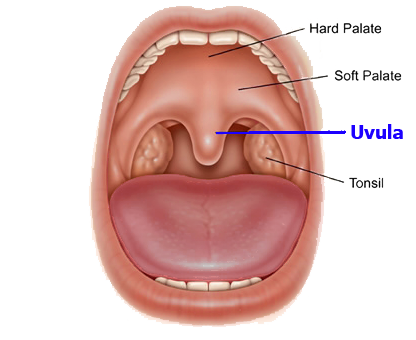| |
Uvulectomy
"If it sticks out, cut it off"?
The uvula is a bell-shaped tissue hanging down the back of the throat.

Its function is unknown, but it may play a role in speech, and it has some glandular tissue indicating that it can produce saliva. It may be removed for legitimate medical reasons, as a treatment for obstructive sleep apnoea [stopping breathing]. Uvulectomy may be performed alone or as part of a larger procedure called a uvulopalatopharyngoplasty (UPPP). Both procedures are to remove tissue that may be blocking the airway.
There is another condition that a uvulectomy is sometimes used to treat called hereditary angioneurotic oedema (HANE). HANE is a rare disease in which the tissues fills with water. If the tissues in and around the throat become too swollen, a person with this condition can suffocate.
Other medical reasons, more controversial, for uvulectomies include treating chronic throat infections and removing abnormally long uvulas to treat chronic coughs.
after About.com
Tribal uvulectomy is here because of its similarities to genital cutting. It is practised in East Africa, including
Kenya,
Eritrea and Nigeria, and
among Bedouins of the South Sinai.
|
Soc Sci Med. 1994 Oct;39(8):1077-82
Traditional uvulectomy in Niger: a public health problem?
Prual A, Gamatie Y, Djakounda M, Huguet D.
Abstract
Although traditional uvulectomy, a procedure which consists of cutting away a part of the uvula, has been reported in several sub-Saharan African countries, in Maghreb and in Israel, epidemiological and anthropological data on this practice are rare. Severe complications may require hospitalization. The goal of this study was to assess the prevalence of this traditional procedure in Niamey, capital of Niger, the incidence of its severe complications and the beliefs and practices related to it. By the age of 5, 19.6% of the children in our survey had undergone uvulectomy. Severe complications of uvulectomy represented 7.8/1000 cases of hospitalization for children under 15 years of age. Complications were infections (including tetanus), hemorrhage and passage of the cut piece of uvula further down the respiratory tract. The children who had undergone uvulectomy belonged significantly more often to the Hausa ethnic group (66.2%) than to the majority Zarma ethnic group (18.3%) or to the other ethnic groups (15.5%). This can be explained by the fact that, in some Hausa subgroups, uvulectomy is systematically performed on the 7th day after birth, during the naming ceremony, to prevent death due to a 'swelling of the uvula'. In the other Hausa sub-groups and in the other ethnic groups, uvulectomy is solely a curative practice, both for children and adults, for vomiting, diarrhea, anorexia, the child's rejection of the breast, growth retardation and fever. Uvulectomy is performed in Niger by the barbers, whose functions are also to perform specialized surgery. These traditional surgeons claim there is no risk to this practice
|
|
ISRN Otolaryngology Volume 2011 (2011), Article ID 704924
The Traditionally Amputated Uvula amongst Nigerians: Still an Ongoing Practice
Adeyi A. Adoga and Tonga L. Nimkur
Abstract
Traditional healers in Nigeria continue to perform uvulectomy for all throat problems despite the severe complications they present to physicians.
It is a hospital-based prospective study done at the outpatient unit of the Department of Otolaryngology, Jos University Teaching Hospital, Jos, Nigeria to determine the prevalence of traditional uvulectomy, highlighting the dangers it portends with suggested ways of providing improved health outcomes for our people. We saw 517 new cases of which 165 (32%) patients aged 2 years to 53 years had their uvulae amputated consisting of 108 (65.5%) males and 57 (34.5%) females giving a male to female ratio of 2 : 1. One hundred and forty two (86.1%) patients had uvulectomy at childhood and 23 (13.9%) in adulthood. The commonest indication was throat pain (n=36, 21.8%). The commonest complication was hemorrhage (n=29, 17.6%). Forty six (27.9%) patients required hospital admission.
|
Related pages:
Back to the Intactivism index page.
| |
